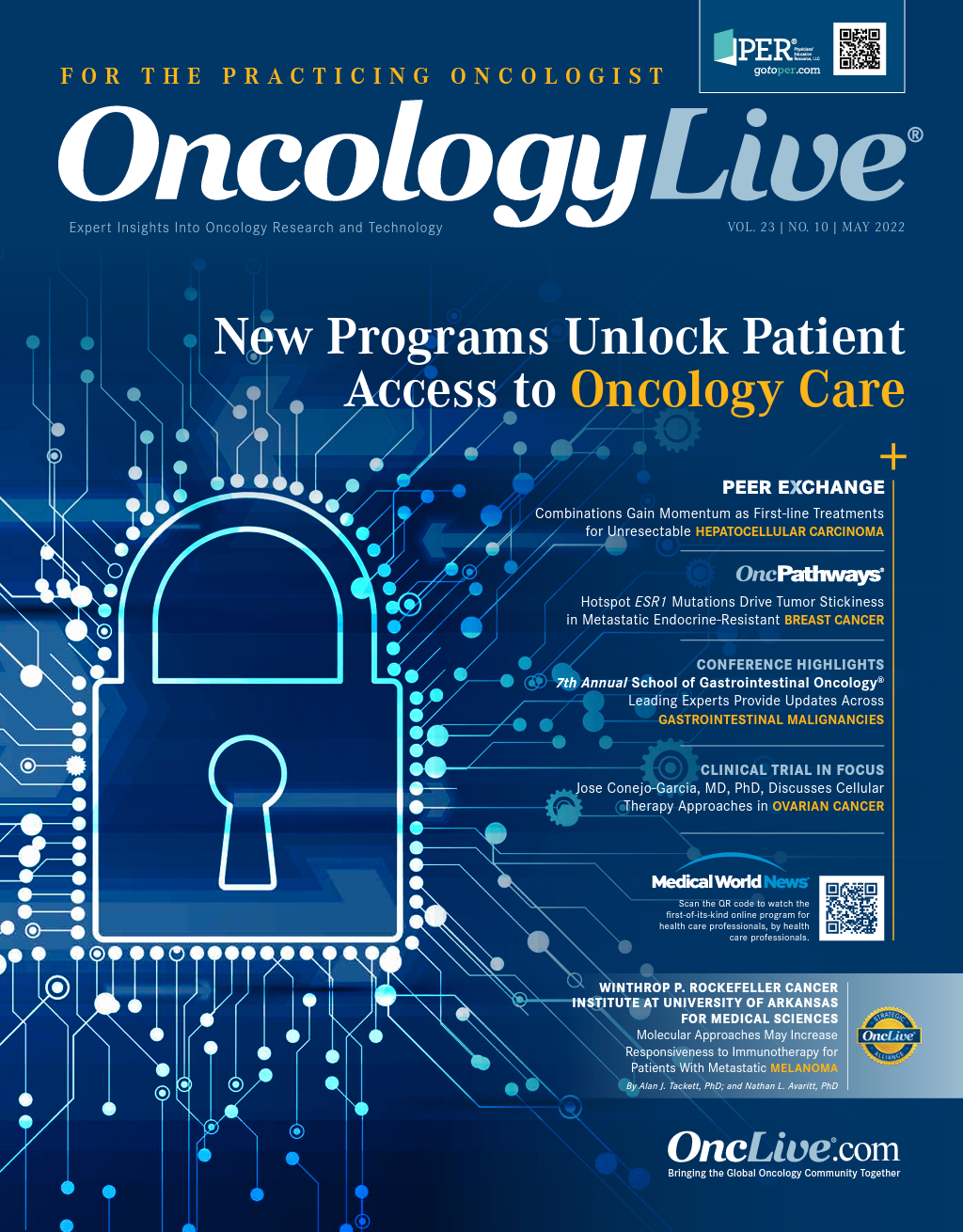Publication
Article
Oncology Live®
The Saga of Regional Therapy in the Treatment of Ovarian Cancer
Author(s):
Despite numerous well-designed and conducted randomized trials, a definitive answer to the role of specific disease management remains unclear, particularly in the discussions of the optimal role for the regional delivery of cytotoxic chemotherapy in the treatment of patients with ovarian cancer.
Maurie Markman, MD

One might reason that the natural progression of cancer clinical trials would dictate that successful earlystage investigative efforts would culminate in the initiation of randomized phase 3 studies to ultimately define a role for a novel approach in disease management.
Although this scenario certainly occurs and has been responsible over the past several decades for the establishment of increasingly effective antineoplastic strategies, for a variety of reasons a large percentage of cancer therapeutics have never been subjected to the rigors of phase 3 testing. One reason for this is that there may not be a regulatory requirement to conduct such studies, for example, with innovative surgical techniques. Another reason may be that the time, effort, cost, and patient resource requirement mandated to initiate and complete randomized studies is simply not practical.
Further, practitioners involved in a particular clinical domain may feel it is not necessary to address certain highly relevant questions in a randomized study. This may be because their clinical experience and training permit them to know the answer in the absence of actual evidence-based data. This phenomenon might at least partially explain the peculiar circumstance under which the role of neoadjuvant chemotherapy in ovarian cancer management has been examined in randomized trials outside the United States, but no study to date has been conducted by the gynecologic oncology community in this country to help provide a definitive answer to this question.1
This commentary addresses what is, essentially, the opposite situation, in which, despite numerous well-designed and conducted randomized trials, a definitive answer to the role of a very specific approach to disease management remains quite unclear. There is likely no better example of this conundrum than in the discussions of the optimal role for the regional delivery of cytotoxic chemotherapy, specifically platinum agents, in the treatment of patients with ovarian cancer.
Tackling Questions in Ovarian Cancer
The concept of regional drug administration in ovarian cancer is remarkably simple and was initially proposed and investigated more than 40 years ago.2 It has been reported that greater exposure of ovarian cancer cells to drugs with known activity in the malignancy (eg, cisplatin, carboplatin, doxorubicin, paclitaxel, 5-fluorouracil) can be safely accomplished with systemic delivery results in increased cytotoxicity.3 However, phase 1 and pharmacokinetic studies have revealed that enhanced exposure can be safely achieved following intraperitoneal drug delivery. For example, for cisplatin and carboplatin, drug concentrations 10 to 20 times greater are measured in the peritoneal cavity when the regional route is employed compared with concentrations observed within the systemic compartment following intravenous administration. For paclitaxel, the concentration difference is 1000-fold.3
Data from multiple phase 2 trials have shown that patients who failed to achieve a surgically documented complete response to platinum-based systemic therapy can achieve this clinical state following the delivery of either cisplatin or carboplatin via the intraperitoneal route.3
Nearly 30 years ago, investigators working with National Cancer Institute (NCI)-supported cooperative group networks initiated several phase 3 randomized trials examining regional drug delivery in the management of ovarian cancer. Their aim was to evaluate the role of consecutive cisplatin-based frontline chemotherapy following initial surgical cytoreduction.3 These efforts revealed the feasibility of the intraperitoneal delivery strategy and strong evidence of a survival benefit compared with systemic cisplatin-based drug administration.3 The results led the NCI to issue a clinical announcement informing the clinical oncology community of the outcome of these several strongly evidence-based studies in January 2006.4
Unfortunately, despite the trial results and the guidance of the NCI, controversy surrounded regional cisplatin delivery in the frontline management of advanced ovarian cancer and major objections to its use continued. Concerns included peritoneal toxicity associated with the agents and the presence of indwelling intraperitoneal catheters.3 In addition, during this multiyear period carboplatin almost completely replaced cisplatin as the platinum agent of choice for systemic treatment of ovarian cancer. The transition was based on evidence of a more favorable toxicity profile which included less emesis, and neuropathy, but no difference in survival outcomes. This change in the standard of care in ovarian cancer treatment served to magnify differences in the systemic adverse effects between carboplatin-based systemic therapy and cisplatin-based intraperitoneal drug delivery.
In addition, although rarely openly discussed, there was a striking differential in the positive financial effect on individual practices and oncology centers associated with the administration of antineoplastic drugs vs the relatively poor compensation for the time and effort required to manage intraperitoneal catheters and their complications.
Progress Stalls in Trial Protocol
To emphasize the absence of general support of evidence-based data, the most recently reported United States cooperative group phase 3 study (NCT00951496) again compared with what is still considered “experimental” regional delivery with a systemic control arm. This protocol was designed despite prior data revealing the survival superiority associated with regional treatment.5 Results of the study failed to confirm a survival benefit with intraperitoneal drug delivery. However, for unclear reasons, this study unfortunately did not include an experimental intraperitoneal arm of cisplatin dosed at 100 mg/m2—the approach employed in 3 previous trials and which demonstrated a survival benefit. Instead, investigators elected to administer an unproved dosing regimen of regional cisplatin at 75 mg/m2.5 In addition, all patients in this trial received bevacizumab (Avastin).
What can we conclude from this 40-year experience? Is it that the dose of cisplatin for frontline regional drug delivery needs to be 100 mg/m2 (and not lower)? That the administration of frontline bevacizumab overcomes the inferiority of systemic platinum-based therapy compared with regional administration and if the anti-angiogenic agent is employed intraperitoneal platinum delivery is not required? Maybe it is a combination of these 2 factors. Or perhaps the last randomized trial is an outlier compared with the published results from the previous 3 and should not be considered definitive. Finally, could we conclude that regional chemotherapy is not worth the time, effort, and cost, despite the existing evidence-based data?
At the recent Society of Gynecologic Oncology 2022 Annual Meeting on Women’s Cancer, investigators from Japan reported the preliminary results of a randomized phase 3 trial (UMIN000003670) that compared regional with systemic delivery of carboplatin without bevacizumab for the frontline chemotherapeutic treatment of ovarian cancer. Results demonstrated a median 3-month improvement in progression-free survival (23.5 months vs 20.7 months; HR, 0.83; P = .041) associated with the intraperitoneal approach.6
What should the gynecologic oncology community do with these data? Start another trial to further explore regional drug delivery, or simply ignore the findings?
References
- Vergote I, Coens C, Nankivell M, et al; EORTC; MRC CHORUS Study Investigators. Neoadjuvant chemotherapy versus debulking surgery in advanced tubo-ovarian cancers: pooled analysis of individual patient data from the EORTC 55971 and CHORUS trials. Lancet Oncol. 2018;19(12):1680-1687. doi:10.1016/S14702045(18)30566-7
- Dedrick RL, Myers CE, Bungay PM, DeVita Jr VT. Pharmacokinetic rationale for peritoneal drug administration in the treatment of ovarian cancer. Cancer Treat Rep. 1978:62:1-9
- Markman M, Walker JL. Intraperitoneal chemotherapy of ovarian cancer: a review, with a focus on practical aspects of treatment. J Clin Oncol. 2006;24(6):988-994. doi:10.1200/JCO.2005.05.2456
- NCI clinical announcement on intraperitoneal chemotherapy in ovarian cancer (January 5, 2006). NCI. Accessed April 29, 2022. ctep.cancer.gov/highlights/20060105_ovarian.htm
- Walker JL, Brady MF, Wenzel L, et al. Randomized trial of intravenous versus intraperitoneal chemotherapy plus bevacizumab in advanced ovarian carcinoma: an NRG Oncology/Gynecologic Oncology Group study. J Clin Oncol. 2019;37(16):1380-1390. Published correction appears in J Clin Oncol. 2019;37(25):2299.
- Fujiwara K, Nagao S, Yamamoto K, et al. A randomized phase 3 trial of intraperitoneal versus intravenous carboplatin with dose-dense weekly paclitaxel in patients with ovarian, fallopian tube, or primary peritoneal carcinoma (a GOTIC-001/JGOG-3019/GCIG, iPoccTrial). Presented at: Society of Gynecologic Oncology 2022 Annual Meeting on Women’s Cancer; March 18-21, 2022; Phoenix, AZ.























%20(2)%201-Recovered-Recovered-Recovered-Recovered-Recovered-Recovered-Recovered-Recovered-Recovered-Recovered-Recovered-Recovered-Recovered-Recovered-Recovered-Recovered-Recovered.jpg?fit=crop&auto=format)
%20(2)%201-Recovered-Recovered-Recovered-Recovered-Recovered-Recovered-Recovered-Recovered-Recovered-Recovered-Recovered-Recovered-Recovered-Recovered-Recovered-Recovered-Recovered.jpg?fit=crop&auto=format)